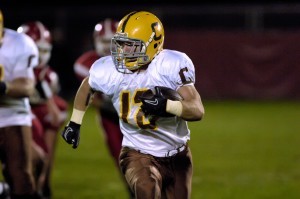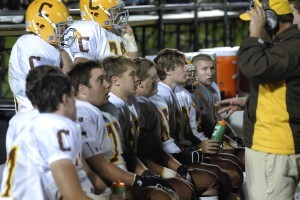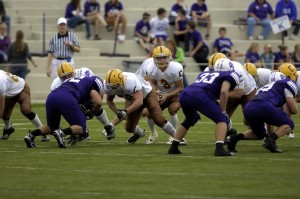Blog: Brown Beginnings, Issue 7
As the release of the non-fiction book The Boys in Brown approaches, author Jon J. Kerr takes readers inside the process. On Tuesdays, the series Brown Beginnings gives readers a behind-the-scenes look at the conception and reporting of the story. Thursdays, he blogs about the writing and publishing steps before launch.
No athletic season is more climatic than a football season. Its once-a-week dynamic gives each contest a heightened sense of meaning and drama.
During my time with the 2010 Carmel Corsairs, I did not miss a game. Because I attended each practice, meeting and film session, by Friday nights, my emotions mirrored that of the players and coaches. I was excited, anxious, restless and impatient. What I felt was a direct result of the time and energy invested. Relationships were built to a level where it mattered to me how the boys and coaches performed each Friday. And it was Friday nights when all involved in the program saw the fruits of their labor.
In 2010, there were 12 such contests. Nine were played in the regular season, three in the playoffs. As I began to write what became The Boys In Brown, a decision had to be made.
What games do I write about in the manuscript?
The obvious answer is all of them. A book about a football season should include sections about the games, right? Buzz Bissinger, author of the 1990 classic book, Friday Night Lights, once said this about his writing process for FNL:
“Each game had to have meaning beyond the x’s and o’s. It had to tie into a larger theme of the world I was capturing in the book.”
I thought about that as I began to write. If sports is a microcosm of society, how can I apply this idea to Carmel? What cultural threads about this community can be woven within the context of a football game?
The fact the Corsairs did not win the state championship that season allowed flexibility. If they had won the whole thing, I would have to write about each game. In some respects, this would have been easier. The drive to immortality becomes the story. But Carmel lost in the state quarterfinals, to St. Rita. This afforded me some elasticity with the narrative. So of the nine regular season games, I decided to write extensively about four.
Here are the four accompanied by a short excerpt from each section:

Photo Credit: Steve Lester
JOLIET CATHOLIC
The game over, players and students wander over to the north end zone. A circle forms, extending out to the 10-yard line. The celebratory cackling hushes. Fans leaving the stands stop and lean against the railing. On the field, all within the circle clasp hands, then take a knee. In the middle of the circle stand four players –– Michael Fitzgibbons, Jake Larson, Michael Cohen and Paul Madison. Still in uniform, they survey the scene unfolding in front of them. They face the crowd. Fitzgibbons stands furthest to the left. He extends out his left hand. Larson grabs it with his right. Madison clasps his right hand with Larson’s left, Fitzgibbons the same with Madison. They wait for a few lingering students to join the circle. All heads bow.
The stadium lights still glow, canopied below a clear September sky. The scoreboard shines. It reads:
HOME 31, GUEST 28
It’s absurdly silent, as if all humanity were taking a deep breath. The Greeks have a phrase for an occasion such as this.
The supreme moment.

Photo Credit: Steve Lester
MARIST
All through his son’s youth football years, Ed had been his son’s coach. He had the voice to prove it, deep and booming, just what is needed when controlling a herd of adolescent boys. Now, amid the orchestra of ambient noise inside Marist’s stadium, he knows Jordan is getting the ball. For so many years, when he was coaching, he’d seen his son in the same situation run through would-be tacklers. This is what he’s seeing tonight. No juking, just straight-ahead power running. The fan in Ed is mesmerized by the sequence of events taking place. But the father in him makes him stand up from his bleacher seat and yell out to his son:
“Let’s go Jordan! Dig deep! Hold onto the football!”
Like a quivering echo reverberating through a cave, Jordan recognizes the cackle from where his father sits. He turns his facemask in the direction of his father’s motivational aphorisms. He nods.

Photo Credit: Steve Lester
MARIAN CATHOLIC
Several minutes later, Wolfy is helped off the field, unable to put any weight on his left leg. Once on the sidelines, he is propped up on the trainer’s table behind the Carmel bench, the injured leg wrapped with ice. Thinking the leg might be broken, Henrichs attaches a splint for the trip home. If so, Wolfy’s football career at Carmel is most likely over.
The development curbs the joyfulness of the 24-0 victory but not its meaning: The Corsairs have clinched a share of the conference championship.
Wolfy’s head rests on the table, both hands at his side, his legs stretched out, one encased in ice. He is motionless, staring upward into a cloudless sky.
Michael Cohen is the first to approach him. Cohen grabs Wolfy’s right hand. Kos limps over and grabs his left. Wolfy moves his head from side-to-side, staring up at Cohen and Kos, their expressions a mixture of intensity and compassion. Within seconds, all of Wolfy’s teammates, coaches and trainers, surround him, hands locked. Coach Ben Berg breaks the silence.
“Our Father, who art in heaven …”

Photo Credit: Steve Lester
ELDER
The purple jersey and pants of the home team provide a startling contrast to Carmel’s brown (pants) and white (jersey). Boosting the inverse chromaticity are the fans. They are decked out in mulberry-stained tops and bottoms (mostly shorts as its a warmer than usual October day), reflecting the school colors. Fans fill out most of the rows behind the home bench. But the atmosphere is detached, complacent. More appropriate for a Yanni concert in the park than a football game. Elder is having an uncharacteristically poor season, losing five of its seven games. That could be the reason for the purple placidity. Or maybe nervousness over the unfamiliarity with these option-running boys from Illinois.
On the other side of The Pit, the visiting stands are peppered in brown and gold. Scott and Beth Carr, parents of the injured senior Matt Carr, along with Bruce and Diane Cappis, parents of running back Ryan Cappis, rented an RV, drove into Cincinnati, and parked the vehicle in the stadium lot. Brian and Tim Serio’s older brother Mike, a running back on the 2003 championship team, flew in from New York to watch his little brothers play. Coach Bitto’s elocution about bringing Carmel’s tradition to Ohio is anything but hyperbole.
Of the three postseason games, the St. Rita game is most written about.
No sport allows a writer as sweeping a canvas as football. All of a community’s bone marrow agglomerates in one location. And while the result matters, in The Boys in Brown, it’s the relationship between the sport, participants and support populace that is most tantamount to telling a truthful story.



